How Long Does Applesauce Last After Opened
Once opened, your applesauce requires immediate refrigeration and proper storage to maintain its quality. Store-bought applesauce typically lasts 7-10 days when stored at 40°F (4°C) or below in an airtight container, while homemade versions stay fresh for 4-6 days. You'll need to place it in the coldest part of your refrigerator, usually the back, and avoid storing it in door compartments where temperatures fluctuate. Always check for signs of spoilage like mold, off-putting odors, or unusual color changes before consuming. Using clean utensils and proper storage containers can greatly extend your applesauce's shelf life and preserve its freshness. The following storage techniques will help you maximize your applesauce's longevity.
This post may contain affiliate links. If you make a purchase through these links, I may earn a commission at no additional cost to you. Additionally, portions of this post may be generated using artificial intelligence (AI) technology. While we strive for accuracy, please be aware that AI-generated content may not always be perfect and should be fact-checked when necessary.
The Spatula Scoops
- Store-bought applesauce lasts 7-10 days after opening when properly refrigerated at 40°F (4°C) or below.
- Homemade applesauce has a shorter shelf life of 4-6 days when refrigerated due to lack of preservatives.
- Immediate refrigeration in an airtight container and storage at the back of the refrigerator maximizes shelf life.
- Check for signs of spoilage like mold, unusual odors, color changes, or off-putting tastes before consuming.
- Freezing applesauce extends its shelf life up to one year, with thawed portions lasting 3-5 days in the refrigerator.
Storage Guidelines for Opened Applesauce
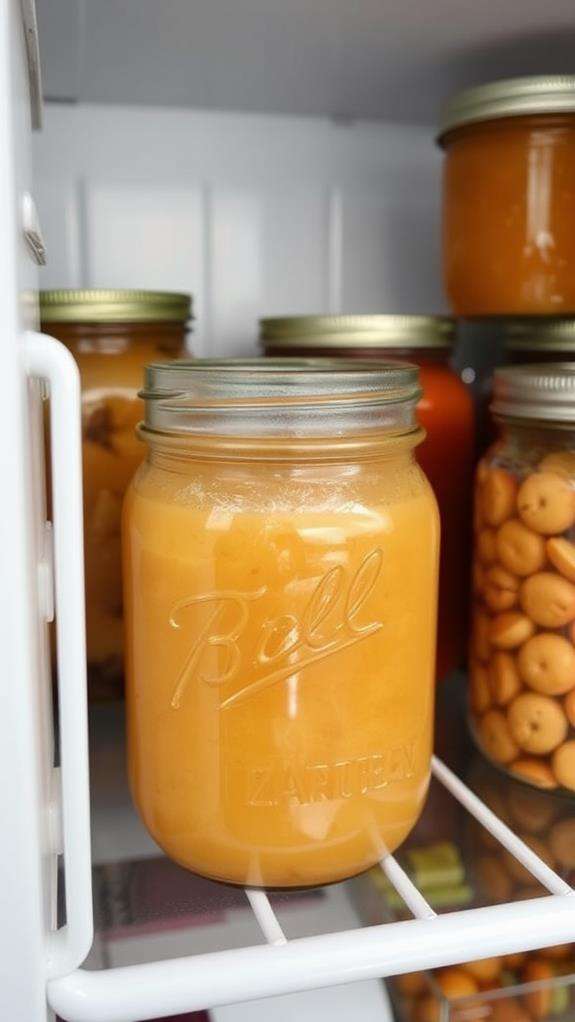
Once you've opened a jar of applesauce, proper storage becomes essential for maintaining its freshness and safety. Unlike unopened applesauce that you can store in a pantry, opened containers require immediate refrigeration to prevent spoilage and maintain quality.
You'll need to transfer your opened applesauce to an airtight container if you're not using the original jar, making sure the lid is sealed tightly to protect against contamination. For best preservation, place the container in the coldest part of your refrigerator, typically toward the back where temperatures remain most consistent. Don't forget to label your container with the opening date, as this will help you track the 7-10 day window during which the applesauce maintains its best quality.
Throughout the storage period, you should regularly inspect your applesauce for any warning signs of spoilage. If you notice unusual odors, changes in color, or any trace of mold, it's time to discard the product. Remember that while proper storage extends shelf life, opened applesauce won't maintain its quality indefinitely, even when refrigerated correctly.
Signs of Spoiled Applesauce
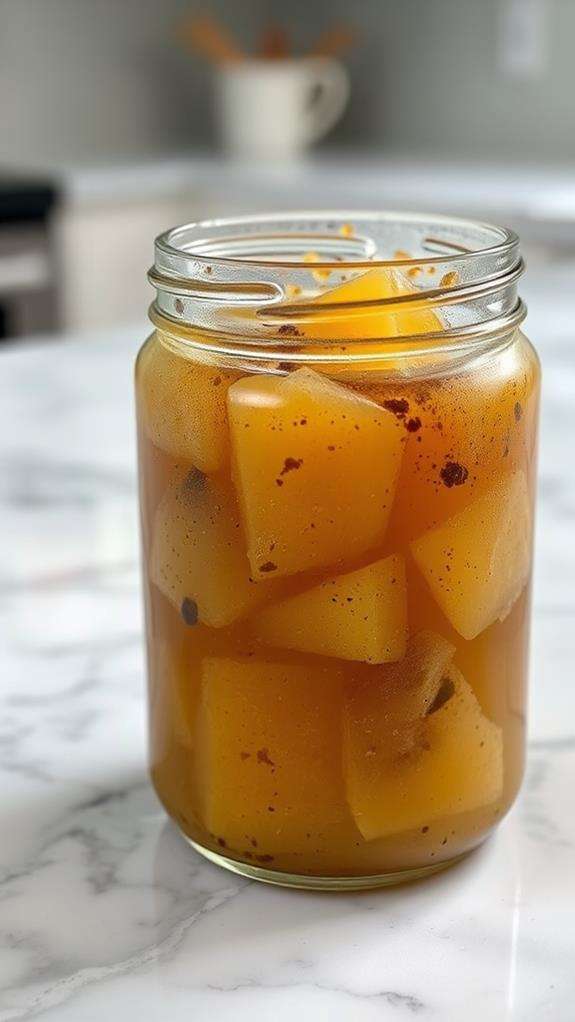
Knowing how to identify spoiled applesauce can protect you from consuming unsafe food and help you maintain proper food safety in your home. Even when properly stored, applesauce can deteriorate, so you'll need to watch for specific indicators of spoilage.
Your first line of defense is your nose. If you detect any sour or off-putting odors instead of the typical sweet apple scent, that's a clear sign of spoilage. You'll also want to examine the applesauce's appearance carefully. Look for any unusual color changes, mold growth (which can appear in various colors), or excess liquid separation on the surface. If you notice the lid of your applesauce container bulging or any signs of leakage, don't take chances – dispose of it immediately.
While visual and olfactory checks are essential, you shouldn't ignore your taste buds. If you've confirmed the appearance and smell seem normal but still have doubts, a small taste test can help. If you detect any sour or unusual flavors that differ from fresh applesauce, stop eating it and discard the remaining product.
Best Storage Temperature
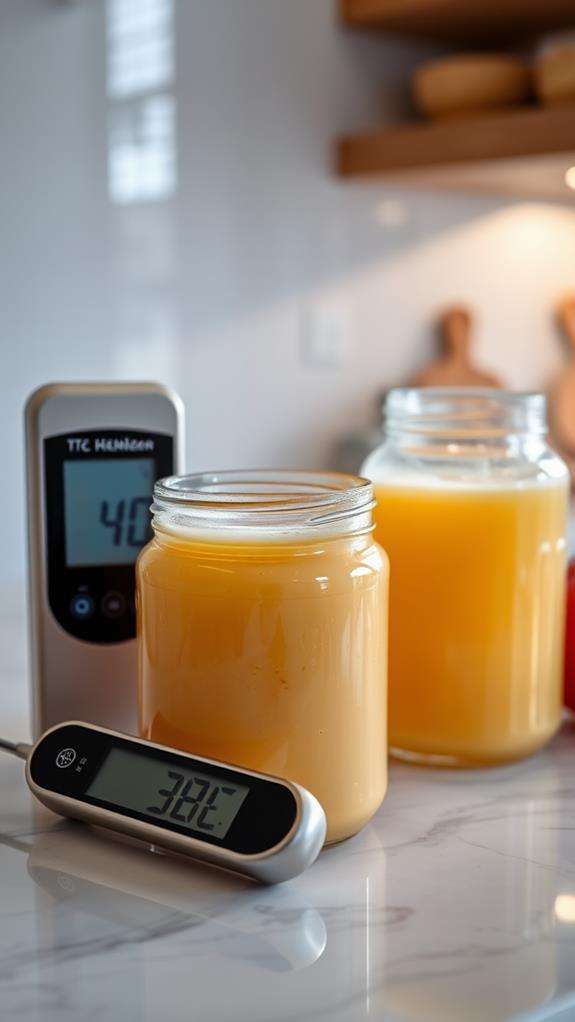
Proper temperature control is essential for maintaining the quality and safety of opened applesauce. To guarantee the best quality of your applesauce, you'll need to store it at a consistent temperature of 40°F (4°C) or below in your refrigerator. This temperature range effectively slows down bacterial growth and preserves the product's freshness.
You'll want to place your applesauce in an airtight container and store it in the coldest part of your refrigerator, which is typically at the back, away from the door. This location helps protect your applesauce from the temperature fluctuations that occur when you're opening and closing the refrigerator throughout the day. Don't make the common mistake of storing it in the door compartments, where temperatures can vary greatly. To maintain peak freshness, you should regularly check that your refrigerator maintains the correct temperature and that your storage container remains properly sealed. Remember, even small temperature variations can impact the shelf life of your opened applesauce, so consistent monitoring is key to preventing premature spoilage and maintaining its intended taste and texture.
Extending Shelf Life
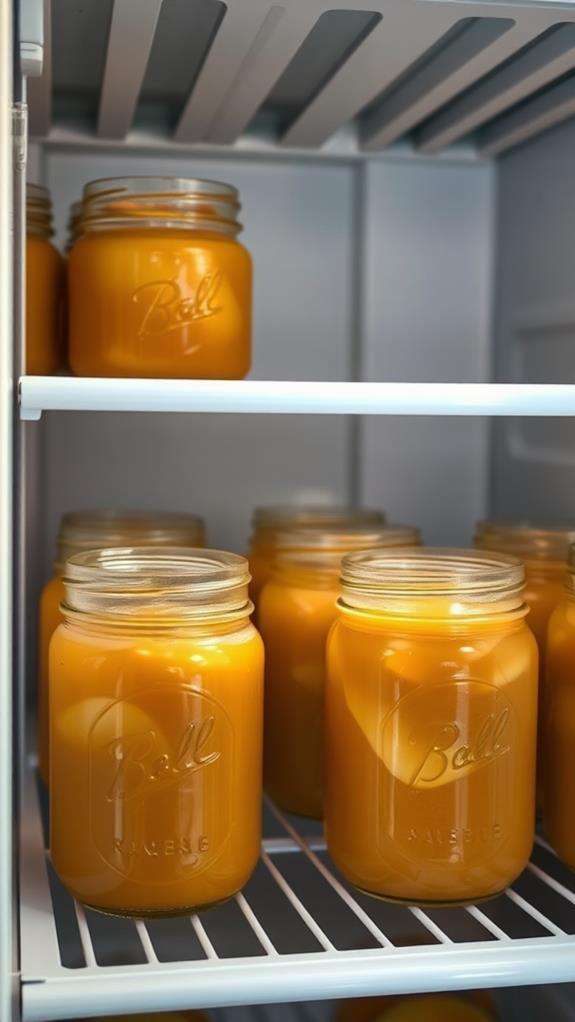
Several practical steps can maximize your opened applesauce's longevity beyond basic temperature control. To extend the shelf life of your applesauce effectively, you'll need to focus on proper storage techniques and handling practices that prevent contamination. Start by transferring your opened applesauce to an airtight container if you're not using the original jar, ensuring the lid creates a proper seal.
Keeping applesauce fresh requires strategic placement in your refrigerator. You'll want to store it toward the back of the shelf rather than in the door compartment, where temperature fluctuations occur more frequently. When serving, always use clean utensils to prevent introducing bacteria that could accelerate spoilage. Don't leave the applesauce sitting out at room temperature; return it to the refrigerator immediately after each use.
Make it a habit to inspect your applesauce before each use. Look for any unusual odors, discoloration, or mold growth on the surface. With these careful storage and handling practices, you can maintain your opened applesauce's quality for 7-10 days. If you notice any signs of spoilage before this timeframe, it's best to discard the product immediately.
Proper Container Selection
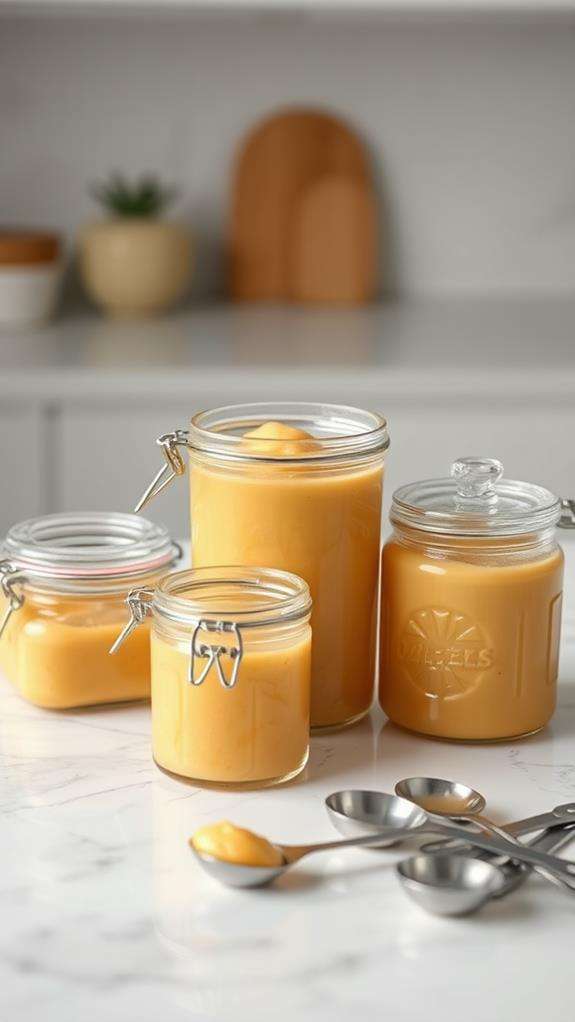
When storing opened applesauce, you'll want to choose between glass containers, which offer superior freshness and prevent flavor absorption, or BPA-free plastic containers that provide lightweight convenience but may absorb odors over time. Your container must have an airtight, leak-proof seal to prevent bacterial growth and maintain the applesauce's quality, regardless of the material you choose. For the most practical storage solution, select containers sized to hold individual portions or weekly amounts, which helps you track freshness dates and reduces the frequency of opening and potentially contaminating the main supply.
Glass Vs Plastic Options
Choosing between glass and plastic containers for storing opened applesauce isn't just about convenience. When you're looking to maximize the shelf life of your jar of applesauce, glass containers offer superior benefits that can greatly influence your food's longevity and quality.
Glass containers provide an impermeable barrier that prevents moisture and odors from affecting your applesauce, ensuring a longer shelf life compared to plastic alternatives. You'll find that glass won't absorb food odors or stains, which can be particularly important if you're storing homemade or organic applesauce varieties. While plastic containers might seem more convenient, they can compromise your applesauce's taste over time through chemical leaching and odor absorption.
When selecting your storage container, you'll want to keep in mind that both options should have airtight seals, but glass provides additional peace of mind regarding food safety. If you're planning to store your applesauce in the refrigerator for an extended period, glass containers are your best bet as they're easier to clean thoroughly and won't retain residual flavors or odors from previous uses.
Airtight Seal Requirements
Proper storage of opened applesauce hinges on selecting containers with reliable airtight seals. When you're choosing a container for your leftover applesauce, you'll need to focus on the seal's quality, as this directly impacts its long shelf life. Look for containers that create a vacuum effect when closed, ensuring maximum protection against air and bacteria.
You'll find that glass containers with rubber-lined lids or high-grade plastic containers with snap-lock mechanisms offer the best airtight seal requirements. When testing a container's seal, try turning it upside down (when empty) to check for any gaps or leaks. If you notice any damage to the lid or sealing mechanism, it's time to replace the container, as compromised seals will accelerate spoilage. For practical storage, you might want to transfer your applesauce into multiple smaller containers with reliable seals. This strategy lets you open only what you'll use soon, while keeping the remaining portions properly sealed. Remember to inspect the container's rim and lid for food residue before sealing, as even small particles can prevent a proper seal from forming.
Container Size Selection
The size of your storage container plays a crucial role in preserving opened applesauce. When you're selecting containers for storage, you'll want to take into account how quickly you'll consume the product to guarantee peak freshness and minimize waste. Standard 16-ounce jars, which hold about 2 cups of applesauce, are ideal if you're regularly using the product or have multiple family members consuming it.
For single-person households or occasional applesauce users, you'll find that smaller 4-ounce containers provide a more practical solution. These portion-sized containers help maintain long shelf life by reducing the frequency of opening and closing larger containers, which can introduce contaminants. When transferring applesauce from its original packaging, make sure you're using freezer-safe containers with secure, airtight lids. Don't forget to label your containers with the date you've opened the applesauce – this simple step will help you track freshness more effectively. If you're planning to store portions for later use, think about dividing larger quantities into smaller containers, as this strategy will help maintain the quality of unused portions while allowing easy access to just what you need.
Cross Contamination Prevention
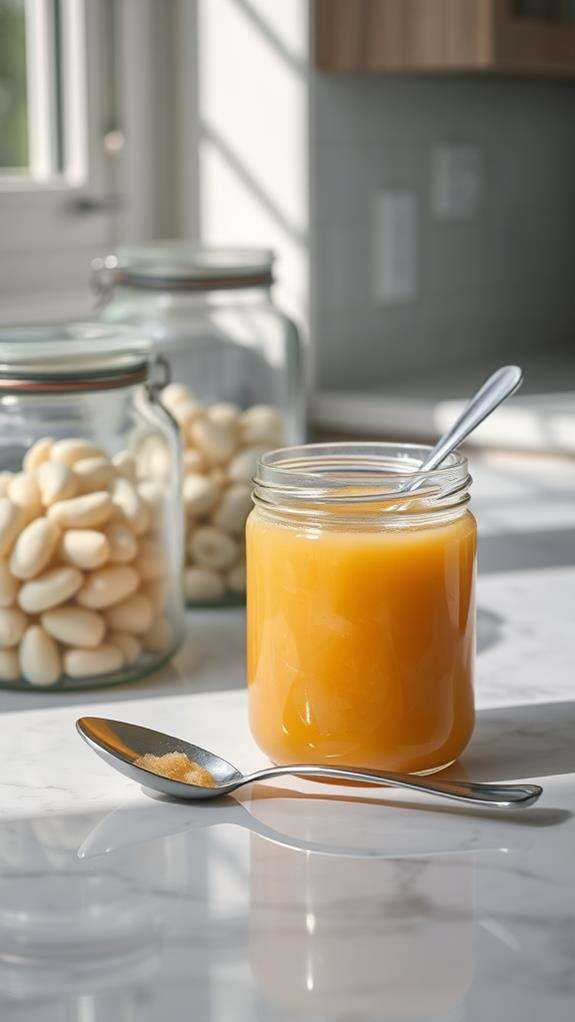
You'll need to be extra mindful of your kitchen tools when handling applesauce, as using contaminated utensils can introduce harmful bacteria that accelerate spoilage. To protect your applesauce from cross-contamination, always reach for clean spoons and serving tools, ensuring they haven't come into contact with other foods or unwashed surfaces. Maintaining separate, dedicated utensils for your applesauce, along with immediate cleaning after use, will greatly reduce the risk of bacterial transfer and help preserve the product's freshness.
Clean Tools Matter Most
Maintaining clean tools when handling applesauce isn't just good practice – it's essential for preventing harmful bacteria from spoiling your preserved fruit. When you're working with applesauce that's stored in a pantry or refrigerator, you'll need to guarantee every utensil that touches the product is thoroughly sanitized.
Here's a practical guide to keeping your tools clean and your applesauce safe:
| Tool Type | Cleaning Method | Usage Frequency |
|---|---|---|
| Plastic Spoons | Hot soapy water | Every use |
| Glass Containers | Dishwasher safe | Before refilling |
| Jar Lids | Sanitizing solution | Each opening |
| Storage Bins | Disinfectant wipe | Weekly |
You'll want to avoid using metal utensils directly in the jar, as they can create microscopic scratches where bacteria love to hide. Instead, opt for clean plastic or silicone tools each time you serve. When transferring applesauce to storage containers, make sure they're properly sealed and free from any residue. Remember to wipe container rims clean before securing lids to prevent contamination and guarantee a proper seal.
Prevent Kitchen Bacteria Spread
Beyond clean utensils, preventing cross-contamination in your kitchen requires a systematic approach to handling opened applesauce. You'll need to create a protective barrier between your applesauce and potential bacterial sources, which starts with proper storage techniques and consistent kitchen hygiene.
To prevent kitchen bacteria spread, you should keep your opened applesauce in an airtight container that's specifically designated for this purpose. Place it toward the back of your refrigerator, where temperature fluctuations are minimal, and avoid storing it near raw meats or unwashed produce. When you're scooping out portions, don't use metal utensils directly in the storage container, as they can create microscopic scratches that become breeding grounds for bacteria. Instead, opt for plastic or silicone serving tools that won't damage the container's surface.
Make it a habit to regularly clean your refrigerator shelves with a food-safe sanitizer, paying special attention to any spills or sticky residue. This maintenance routine helps eliminate hidden bacterial colonies that could contaminate your applesauce and other stored foods through indirect contact or airborne particles.
Freezing Methods and Tips

Freezing applesauce effectively extends its shelf life up to a full year, making it an excellent preservation method for bulk purchases or homemade batches. When you're planning to freeze your applesauce, you'll need to take into account proper storage containers and spacing to maintain quality throughout the freezing process.
To achieve the best freezing methods, start by selecting freezer-safe containers or double freezer bags for storage. You'll want to leave approximately 1/2 inch of headspace at the top of each container, as the applesauce will expand during freezing. If you're looking for convenient portion control, try freezing applesauce in ice cube trays – this method creates perfect single-serving sizes that you can easily thaw when needed.
Don't forget to label your containers with the storage date, as this will help you track freshness and make sure you're consuming the applesauce within its ideal timeframe. Once you've thawed your frozen applesauce, you'll need to use it within 3-5 days if stored in the refrigerator. Remember, you shouldn't refreeze previously thawed applesauce, so only defrost what you plan to consume.
Homemade Versus Store Bought Longevity
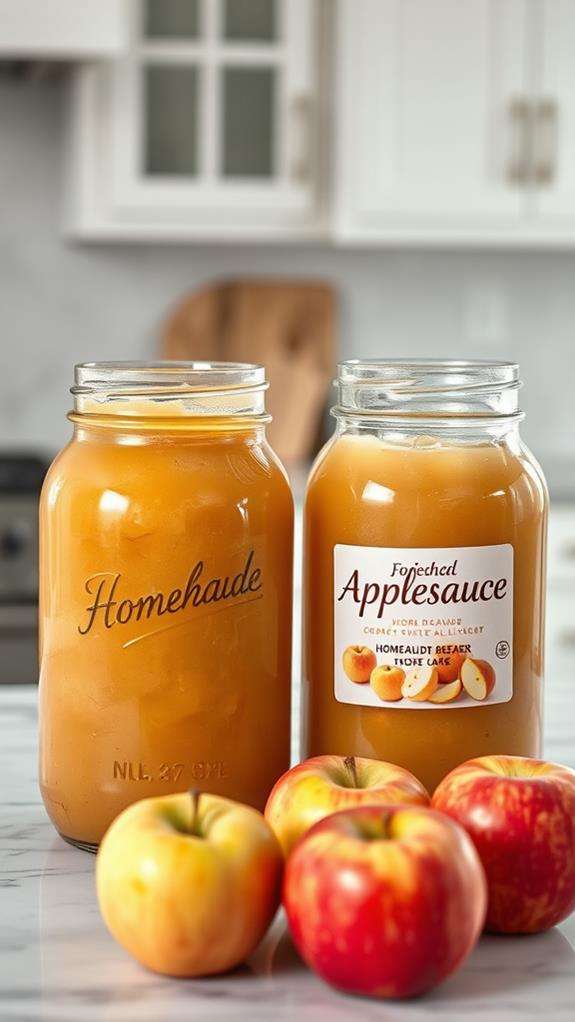
A notable difference exists between homemade and store-bought applesauce when it comes to shelf life after opening. If you're storing homemade applesauce, you'll need to consume it within 4-6 days, while store-bought varieties can maintain their quality for 7-14 days after opening. This difference primarily stems from the preservatives manufacturers add to commercial products.
To maximize the shelf life of both types, you'll want to follow these essential storage practices:
- Keep your applesauce in an airtight container
- Store it in the coldest part of your refrigerator
- Check regularly for signs of spoilage, such as mold or off-putting odors
When you're choosing between homemade applesauce and store-bought varieties, consider how quickly you'll consume it. While homemade options offer fresher taste and control over ingredients, they require more vigilant monitoring due to their shorter shelf life. Store-bought versions give you more flexibility with consumption timing, but you'll need to pay attention to the manufacturer's guidelines on the label. Remember, proper storage conditions are vital regardless of which type you choose.
Frequently Asked Questions
How Do You Tell if Applesauce Has Gone Bad?
You can spot spoiled applesauce through several key signs. First, check for any unusual odors – fresh applesauce should smell sweet, not sour. Look carefully for discoloration or mold growth, and check if there's excess liquid pooling on top, which suggests fermentation. If you're still unsure, taste a tiny amount – it shouldn't be sour or off-flavored. Remember, even without obvious signs, it's best to discard opened applesauce after 5-10 days.
How Long Can You Keep Applesauce in the Fridge After Opening?
Properly preserved and promptly placed in your refrigerator, opened applesauce stays fresh for 7-10 days. You'll want to keep it tightly sealed and stored in the back of your fridge, not in the door, to maintain its quality. If you've made homemade applesauce, you'll need to use it more quickly – within 4-6 days. For the best flavor and safety, you should aim to finish store-bought applesauce within a week of opening.
How Long Are Applesauce Pouches Good for After Opening?
Once you've opened an applesauce pouch, you'll need to consume it within 5-7 days for the best quality and safety. You should store it in the refrigerator immediately after opening, and it's best to keep it in an airtight container to prevent contamination. Before eating, check for any signs of spoilage like unusual smells, color changes, or mold. Remember, these guidelines may vary slightly based on your specific brand's recommendations.
What Is the Shelf Life of Unsweetened Applesauce?
Once you've opened unsweetened applesauce, you'll need to store it in the refrigerator, where it'll stay fresh for 5-10 days in an airtight container. You'll get the best shelf life by keeping it in the coldest part of your fridge, not the door. If you'd like to extend its life, you can freeze unsweetened applesauce for up to a year. Always check for signs of spoilage like odd smells, discoloration, or mold before eating.





